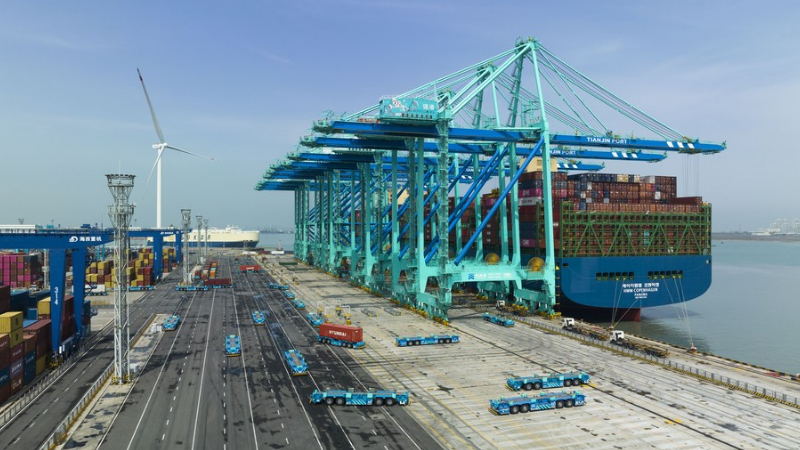
This photo taken on March 15, 2023 shows cargo trucks waiting to depart from the highway port in Manzhouli, north China's Inner Mongolia Autonomous Region. (Xinhua/Bei He)
TIANJIN, April 20 (Xinhua) -- On an online digital freight platform, a truck driver can find suitable freight orders in a few minutes, enabling his truck to head for the next destination without being empty.
"This platform is like a freight-version taxi-hailing app," said Chai Shuman, an official with the iron and steel enterprise Rockcheck Group. It uses machine learning, automation and other software services to connect shippers and carriers.
The platform's business covers 30 provinces, regions and cities. Its "intelligent dispatching" function means carriers can avoid driving between locations with empty loads, Chai added. Being able to match any truck to any shipment creates a more efficient network with lower market transaction costs.
Since the digital freight platform was developed by Rockcheck in 2018, it has seen 172,000 vehicles registered and a cumulative shipment volume of over 82 million tonnes.
The platform's progress reflects the rapid development of China's digital freight industry under the tide of informationization.
In 2022, the market size of China's highway freight was about 5 trillion yuan (about 725 billion U.S. dollars), of which the overall market size of digital freight transport is about 700 billion yuan. China had 2,537 network freight enterprises (including branches) by the end of 2022. A total of 94.01 million waybills were uploaded throughout the year, up 36 percent year-on-year, according to a report on China's digital freight development.
"In recent years, the market scale of digital freight platforms has rapidly grown with its economic and social benefits appearing. Its business model has also gradually differentiated," said Zhou Zhicheng, an official with the China Federation of Logistics and Purchasing.
A leading enterprise in the logistics industry, Full Truck Alliance, has given full play to its advantages of "platformization," digitalization, and networking to reduce costs, increase efficiency and improve carrying capacity with the big data of freight transport.
"Digital freight transport shows prominent advantages," said Kong Qingfeng, an official with Full Truck Alliance. It can realize the process of freight settlement and contract signing online and also narrow the distance between enterprises and drivers.
The report shows that online freight platforms can increase vehicle utilization efficiency by about 50 percent, increase drivers' monthly income by 30 to 40 percent, and reduce transaction costs by 6 to 8 percent compared with the traditional freight mode. "The time for drivers receiving waybills has reduced from three or four days to several hours or even minutes," Kong said.
The carbon emissions from road transport in China account for more than 80 percent of that in the whole transportation field, of which the carbon emissions from freight transport account for more than 60 percent. The reduction of the empty-load rate plays a key role in saving energy and reducing carbon emissions, according to the report.
Many experts said digital freight transport enjoys a promising future and will continuously release new growth drivers to boost China's real economy.
China will be able to rely on the construction of digital freight industry cluster zones and institutional innovation demonstration zones to promote the digital transformation of the freight industry deeper and wider and prop up the high-quality development of the real economy, said He Dengcai, an official with China Federation of Logistics and Purchasing. ■












